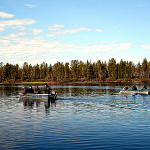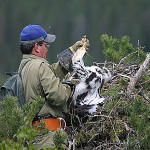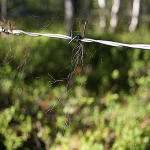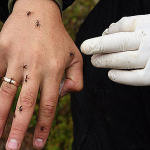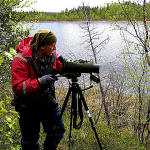

Home
Area
Vätsäri
Övre Pasvik
Pasvik Zapovednik
Nature
Geology
Climate
Water system
Flora
Fauna
Culture
Population
Religion
Sources of livelihood
Old ways of life
Time of industrialism
History
Stone Age
Early Metal Age
Late Metal Age
Middle Ages
Towards modern times
Timeline
Cooperation
Nature monitoring
Nature tourism
Publications
Contacts
Visit Pasvik-Inari
Guidelines
Regulations
News
Links
Nature monitoring
Several species surveys have been conducted in Pasvik River surroundings as Finnish-Norwegian-Russian cooperation. The aim is to compile adequate information about the species and to develop long term monitoring in order to ensure sustainable management of the protected areas.
A Norwegian research institute Bioforsk Svanhovd has conducted annual waterfowl calculations on Pasvik River from 1995. Pasvik Zapovednik has participated in these calculations. In Finland, a survey of the birds of the Lake Inari area was published in 2007 and during the same year an annual waterfowl calculation was initiated. The Finnish waterfowl calculation area covers the mouth of River Ivalojoki.
The territories of the Golden Eagle are currently mapped in all three countries using a common methodology. Mapping the territories across the borders provides better information about the population and improves the estimates of cost caused by Golden Eagle to reindeer economy.
Samples of brown bear faeces and hair have been collected in all three countries in order to compile more information on the brown bear population in the Pasvik-Inari area. New methodology to catch the hair samples by using hair snares was tested in 2007. The hair or faeces collected is brought to the laboratory where the DNA is extracted and analyzed. With the genetic information the researchers are able to identify individuals and find out their sex and relationships. The number of times an individual bear is detected at one or more locations is used to estimate how many bears live in a particular area. That is how researchers get an estimate of the numbers of bears moving in the study area.
Invertebrate organisms, such as ants, butterflies and beetles, play a key role in the ecosystem function. Invertebrates are considered as indicators of the possible changes in the environment caused by direct or indirect human activities. Some groups of invertebrates are more sensitive to changes than others. Basic knowledge about the species and their responses is needed for future monitoring. In Pasvik-Inari several studies on invertebrates have been carried out. In 2007 a monitoring method using ants as a focal group was tested in each country.
The biotopes listed in EU Habitats Directive found in Vätsäri wilderness area have been mapped for as part of a national programme. In Pasvik Zapovednik a landscape mapping has been carried out. In Norway the natural biotopes are currently surveyed. Information about the surveys has been exchanged in order to evaluate the similarities in the methodologies.
